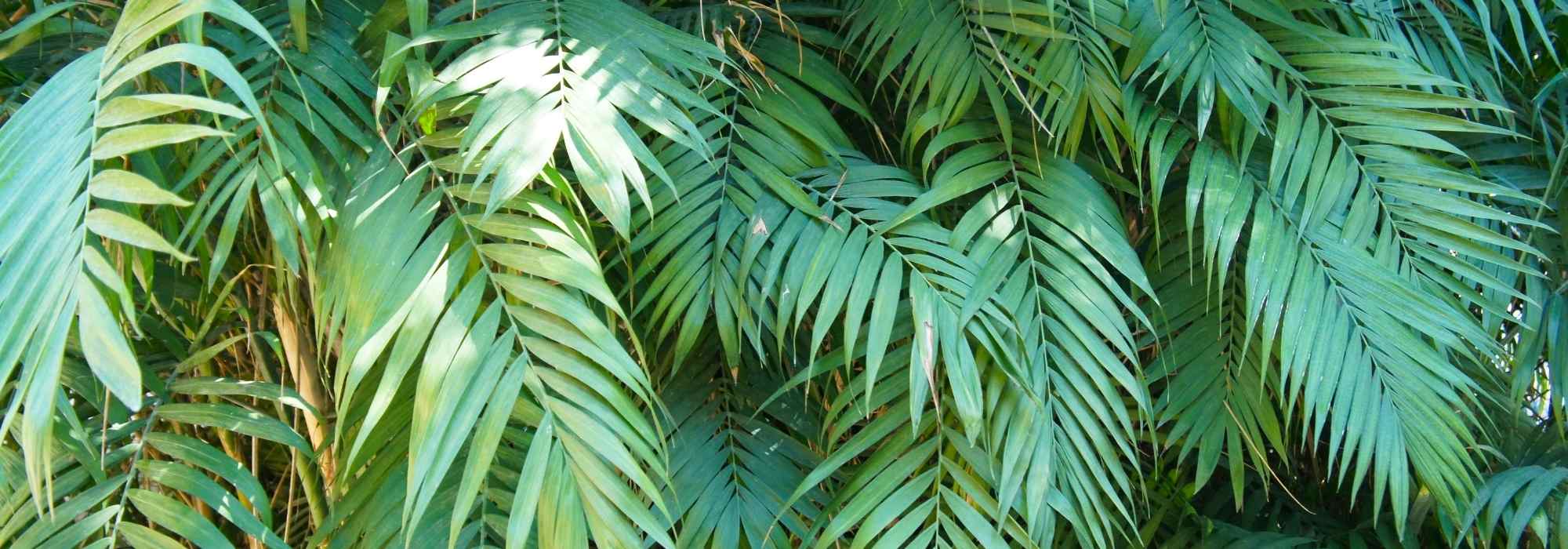
Chamaedorea: planting, care
Contents
The Chamaedorea in a nutshell
- It is undoubtedly one of the best indoor palms
- This is a superb small palm with an elegant habit
- Being frost-sensitive, it can only be grown outdoors in gardens spared from frost
- It is a shade or partial shade plant that thrives in moist soil
- It will add a magnificent exotic touch to the garden or indoors!
The word from our expert
The Chamaedorea is a beautiful dwarf palm with an elegant habit, primarily suited for indoor cultivation in our latitudes. Very sensitive to cold, it is nonetheless quite easy to acclimatise in a pot, which can be moved outdoors during the warmer months or kept in a conservatory or bright room. It is a stunning houseplant, accessible to every gardener, even beginners. As a bonus, it has air-purifying qualities, helping to cleanse the air in your home!
The Chamaedorea can only be grown outdoors in the most sheltered gardens in our country, along the Atlantic or Mediterranean coasts. When planted in the ground, it will not exceed 3 metres in height, and around 1.5 metres when grown in a pot. In a pot, it will require a bit more maintenance and will appreciate repotting every three to four years.
With its decorative foliage year-round, divided into large leaflets or split fronds, it has a unique presence that adds a touch of exoticism to any setting, much like its most popular representative, the Chamaedorea elegans.
It dislikes scorching sun, preferring partial shade or even dappled shade, but is content with good, fertile, and moist soil.
Discover this mini palm for mild gardens or indoor spaces!
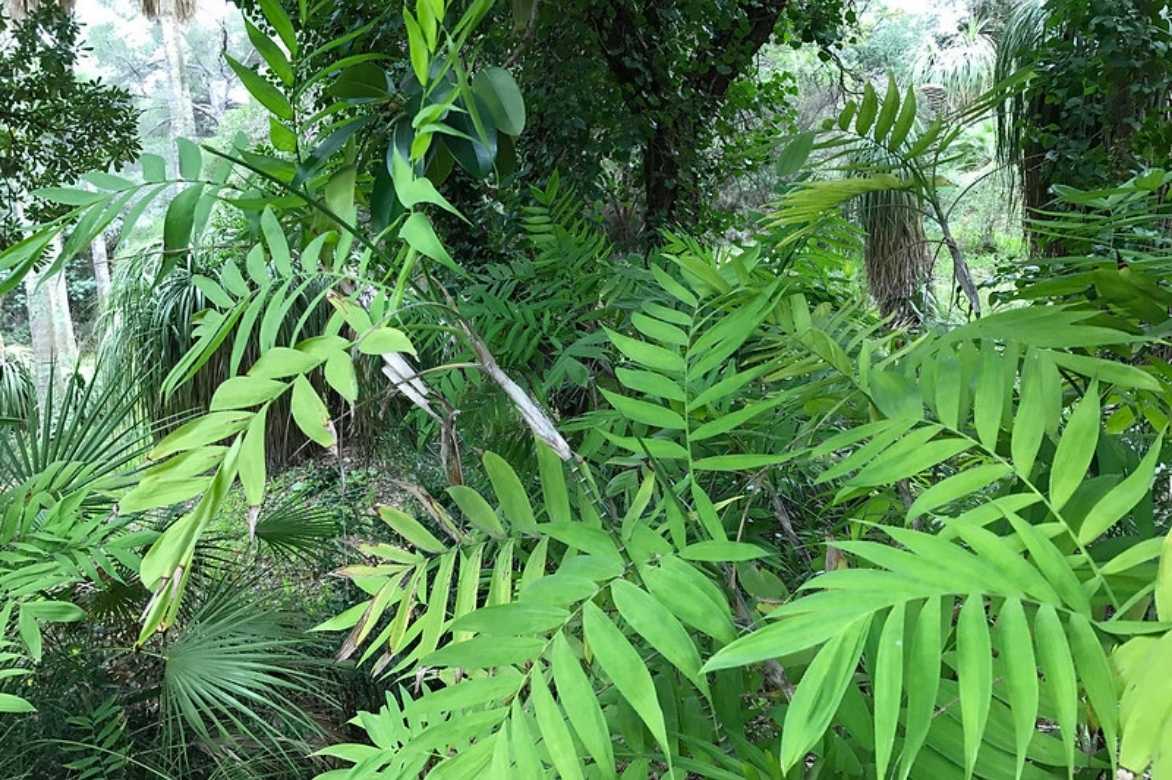
Chamaedorea at the Jardin du Rayol © Jean-Michel Dupuyoo
Description and Botany
Botanical data
- Latin name Chamaedorea
- Family Arecaceaes
- Common name Chamaedorea, Parlour Palm
- Flowering summer
- Height 1 to 3 m
- Sun exposure Partial shade
- Soil type Rich, moist, well-drained
- Hardiness Frost-sensitive
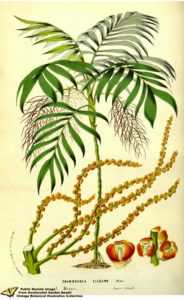
Chamaedorea elegans. Botanical plate from 1858
The Chamaedorea is a small to medium-sized palm tree from the Arecaceae family, which includes palm trees. It is native to the humid tropical forests or wooded mountains of South America, Central America, and Mexico. The genus Chamaedorea comprises around 120 species of small palm trees, among which the most common is the Chamaedorea elegans, “elevated chamaedorea” or “mountain palm”, the Chamaedorea klotzschiana, rarer in cultivation, the Chamaedorea ernesti-augusti, “Ernest August’s palm”, another small-growing species, or the Chamaedorea metallica, a dwarf species with blue leaves.
This palm grows slowly, adding about one ring per year. It does not grow very tall, rarely exceeding 3 to 5 metres in height at most in open ground, and adapts perfectly to pot cultivation, fitting easily into a small garden. It is not very hardy and can only be grown outdoors in the mildest regions, which is why, in our latitudes, it is cultivated indoors in pots, where it will not exceed 1.50 to 1.80 metres in height with a spread of 90 cm.
The habit is slender and very graceful, much like the Chamaedorea elegans. The Chamaedorea, like all palm trees, develops a trunk or stipe. In this palm, it is narrow, 2 to 5 cm in diameter. Marked by the rings of old petioles and green in colour, it resembles a bamboo cane.
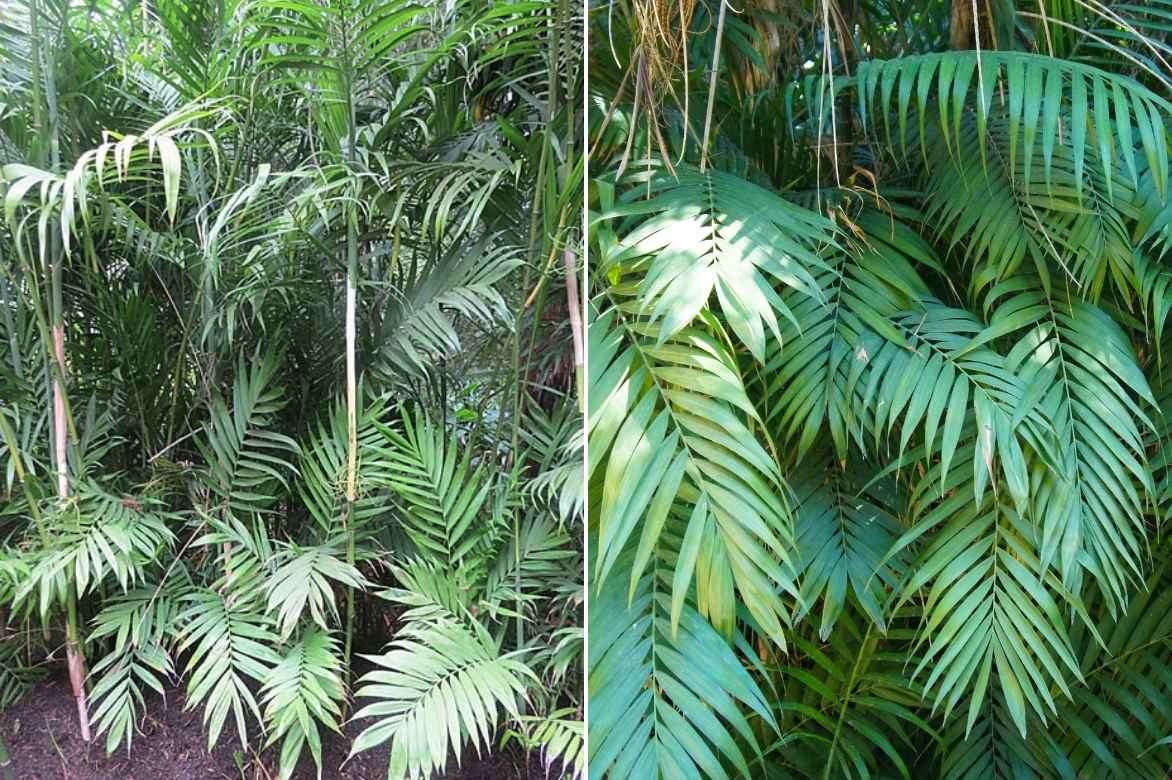
Chamaedorea costaricana (© Dick Culbert) and Chamaedorea elegans
At the top of each trunk unfolds a crown of evergreen foliage that remains decorative all year round. From the stipe emerge large leaves that add a lot of exotic appeal. The foliage, however, varies depending on the species, being segmented or notched. The leaves can be pinnate, divided into large and numerous pairs of leaflets, or bifid, meaning split into two segments at their tip like a fish’s tail. These fronds can measure up to 80 cm long and 30 cm wide. They lengthen over time. This type of palm produces 2 to 3 new fronds per year, each living for several years. Like other palm trees, they are thick, leathery, and traversed by numerous parallel veins. The leaves are green in colour, ranging from a beautiful light green to dark green, sometimes with a metallic blue hue.
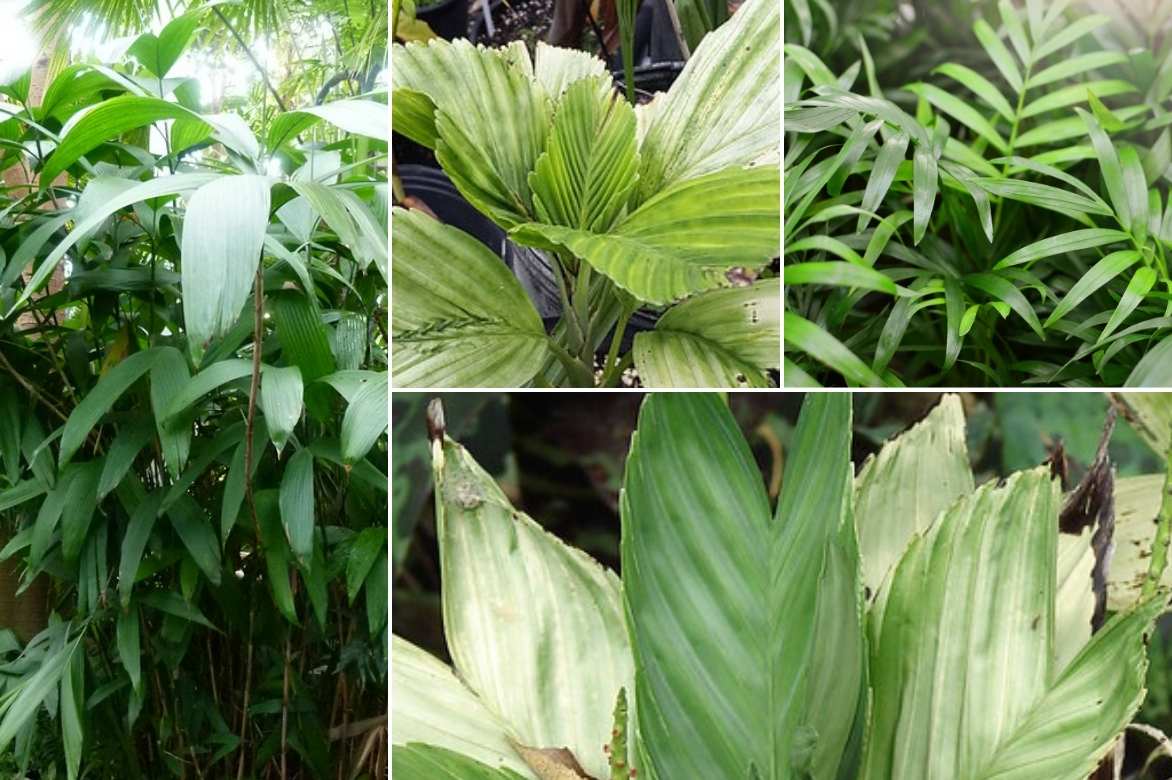
The foliage varies among Chamaedoreas, here from left to right: Chamaedorea fragrans (© Jungle Rebel), Chamaedorea tuerchkeimii (© Daniel Rengel), Chamaedorea elegans and Chamaedorea metallica (Forest and Kim Starr)
Flowering occurs between May and October, after 3 or 4 years of cultivation, but it is very rare in cultivation. Indoors, the plant tends to flower more easily. The flowering emerges near the stipe, between the leaves. It takes the form of panicles of generally yellow flowers, clustered in glomerules like those of the mimosa, 15 to 40 cm long, erect, simple or branched. The flowers are orange-red in the Chamaedorea ernesti-augusti and are gathered in clusters on erect then trailing branches, giving the inflorescences of this species a curious tentacle-like appearance.
It is a dioecious tree, meaning there are male plants, with only male flowers, and female plants with only female flowers. The flowering looks different depending on whether the plant is male or female, and both genders must be present for the plant to bear fruit.
The flowers then turn into small, round, inedible and toxic fruits, coral or red in colour, turning black when ripe.
Placed in the home, the Chamaedorea absorbs pollutants present in indoor air such as tobacco or volatile organic compounds (VOCs) from paints, cleaning products, particleboard furniture, or floor coverings.
Main species
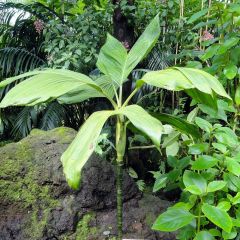
Chamaedorea ernesti-augusti - Parlour Palm
- Height at maturity 1,80 m
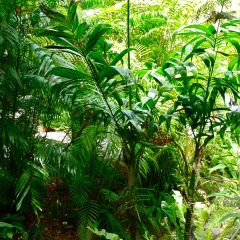
Chamaedorea klotzschiana - Parlour Palm
- Flowering time August, September
- Height at maturity 3 m
Discover other Chamaedorea
View all →Available in 1 sizes
Planting Chamaedorea
Where to Plant Them?
Most Chamaedoreas require warmth. They are very sensitive to cold, tolerating only -1 to -4°C at most, and only briefly. This is why, in our latitudes, they are easier to acclimatise in pots in a conservatory or a bright room rather than in open ground. This type of palm can only be planted in open ground in the most sheltered gardens of the French Riviera or the Atlantic coast. Provide them with a sheltered spot, protected from cold and dry winds, in partial shade, as they dislike harsh sunlight. The ideal location is under the canopy of large trees.
In frost-free regions, they appreciate soil that is consistently slightly moist, light, rich in compost, and well-drained.
Elsewhere, they can be grown in pots to adorn the terrace during the warmer months and should be moved to a frost-free shelter in colder regions or make for a stunning orangery plant indoors. In this case, place your pot in a very bright spot, as the Chamaedorea adapts to any heated room between 12 and 20°C maximum (never below 10°C), while avoiding direct sunlight, nearby radiators, and draughts. Indoors, they prefer filtered light, sheltered from the sun’s scorching rays.
In open ground, Chamaedoreas naturally blend into the heart of an exotic bed or stand alone on a short grass meadow. As these are compact palms, they are easy to grow in a large pot, which you can place, for example, on a terrace or balcony to add a magnificent exotic touch.
When to Plant Chamaedoreas?
We recommend planting Chamaedoreas in spring, around March to May, after the last frosts. In pots, you can plant them as late as September.
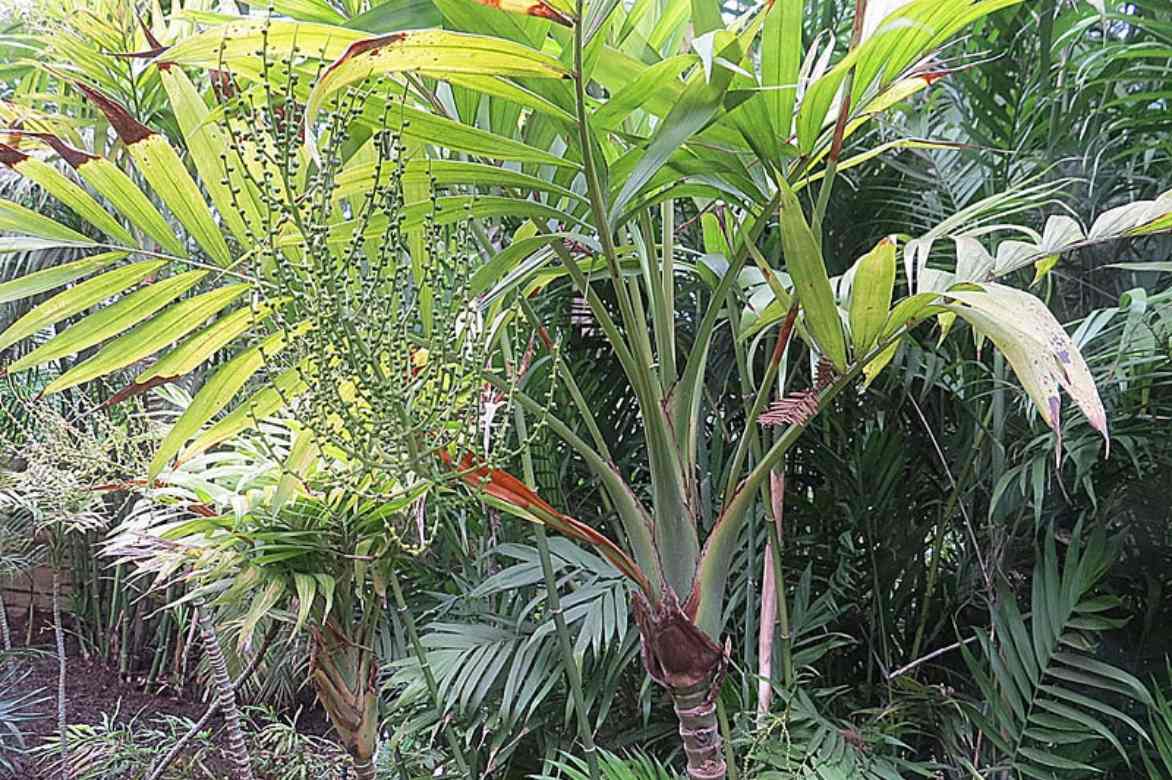
Chamaedorea elegans (© Dick Culbert)
How to Plant Them?
In Open Ground
Choose a well-sheltered spot in filtered shade, away from direct sunlight, which could scorch the foliage.
- Dig a large planting hole, two to three times the size of the root ball
- If your soil tends to retain water, spread a layer of gravel or clay pebbles at the bottom of the hole
- Place the palm in the centre, ensuring it stands upright
- Fill with a mixture of turf and soil, avoiding burying the base of the trunk
- Water generously
- Mulch around the base to keep the soil cool
In Pots
This palm is easily grown in pots, to be placed on the terrace in summer and brought indoors to shelter from frost in winter. You can plant several specimens per pot.
- Choose a pot with drainage holes, at least 30 to 40 litres in size
- Spread a layer of drainage material at the bottom of the pot (clay pebbles, broken pottery, etc.)
- Plant your palm without burying the trunk in a mix of good garden soil, houseplant compost, and coarse sand
- Water moderately
- Place it in shade or indoors
Maintenance
In the Ground
Chamaedoreas require water and the soil should remain cool in summer. The soil should stay moist but not waterlogged. In winter, water only if rainfall is scarce. Water once or twice a week in summer. Mulch around the base to keep its roots cool in summer and warm in winter.
Apply organic fertiliser (compost) in spring and summer by lightly scratching it into the soil around the base of your palm.
We recommend protecting it during winter by wrapping it in horticultural fleece.
In Pots
Be mindful of the slightly dry atmosphere in heated interiors during winter! When grown in pots indoors, Chamaedoreas need high and consistent humidity. Water once or twice a week in summer with rainwater or mineral water at room temperature, allowing the substrate to dry out between waterings. You can spread a layer of clay pebbles in the saucers.
Apply organic fertiliser for houseplants once a month from April to September.
At the first sign of cold weather, if you live in a cold region, bring your pots indoors or into a greenhouse (ideally at 18-20°C) in a bright spot, but avoid direct sunlight and draughts. Mist the foliage regularly with clean water, then gently wipe the leaves with a damp cloth or sponge. Reduce watering in winter to once a week, allowing the substrate to dry out slightly between waterings, and stop fertilising.
Cut dried leaves at the base of the stem.
You can move your pots back outside in spring after the last frosts.
Also consider repotting in spring, when the roots have outgrown the pot, on average every 3-4 years, each time choosing a slightly larger pot. Alternatively, you can simply top-dress annually by adding a fresh layer of compost a few centimetres thick.
Diseases and parasitic pests
The Chamaedorea is rarely diseased. If brown spots appear on the leaves, this is likely due to scorching from direct sunlight. Move your plant to a less exposed location and trim the affected leaves. If there is a lack of water, the leaf tips may dry out.
Indoors, if the ambient air is too hot and dry, the red spider mites can threaten the foliage: mist the leaves regularly, as they dislike humidity.
In case of overwatering, rot threatens your palm: allow the soil to dry out thoroughly before resuming more moderate watering. If necessary, you can repot it in fresh, well-draining soil, ensuring a good layer of clay pebbles at the bottom of the pot and adding some coarse sand to the planting mix.
The mealybugs leave small white cottony clusters under the leaves: in case of infestation, remove them with a cotton pad soaked in 90°C alcohol and spray with rapeseed oil.
To learn more, also check out our article: “Diseases, Parasites, Deficiencies: Everything That Can Affect Your Chamaedorea”.
Multiplication of the Chamaedorea
The Chamaedorea is propagated by sowing, but this operation is delicate and lengthy. It is reserved for expert gardeners. It requires constant warmth (25-27°C) and humidity. The seeds are sown in spring in a tray filled with compost and placed in a heated greenhouse. Germination is slow and can take up to 3 months. Transplant the young plants into buckets filled with compost and let them grow stronger before transplanting them into the garden or into pots.
Pair
With its lush foliage, the Chamaedorea palm creates an exotic atmosphere or beautiful Mediterranean scenes.
In regions spared from frost, in a partially shaded bed, surround it with Yucca, and other palms that appreciate filtered light, such as Phoenix roebelinii, Japanese banana trees (Musa basjoo), and other plants with lush foliage, like Gunnera, Euphorbias, Tetrapanax papyrifera ‘Rex’, or arborescent ferns.
In a more mineral composition, it pairs well with Phormiums, Cordylines, and Hakonechloa macra ‘Aureola’, with their graphic and colourful foliage, as well as small Fargesia bamboos like ‘Bimbo’.
You can complement it with the vibrant flowering of Crocosmias and Cannas.
It can also be planted in a very large pot on the terrace or near a swimming pool, with a carpet of golden pearlwort or plectranthus at its base.
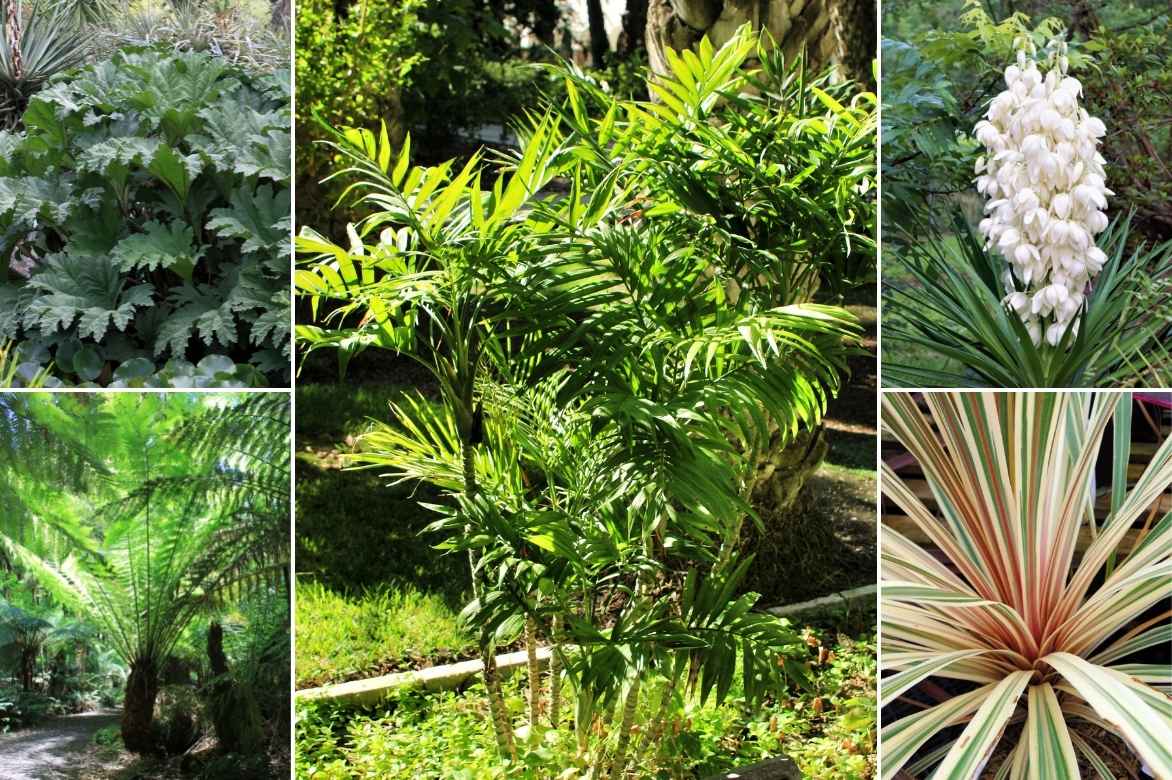
Chamaedorea elegans in the centre, accompanied by Gunnera manicata, Dicksonia antarctica, Yucca, and Cordyline australis ‘Torbay Dazzler’
Useful resources
- Our advice sheet: Palm trees by climate
- All our cultivation tips: “Palm trees: Planting, growing and caring for them”
- Discover our full range of palm trees.
Frequently asked questions
-
Why are the leaves of my Chamaedorea turning dry?
In case of lack of water and excessive sun, the tips of the palm tree's leaves will tend to dry out. The leaves may scorch if placed directly in full sun. Partial shade is preferable, and watering should be carefully managed. Chamaedoreas require regular water and a consistently humid atmosphere. You can trim the tips of the leaves if they are completely dry.
- Subscribe!
- Contents

































Comments